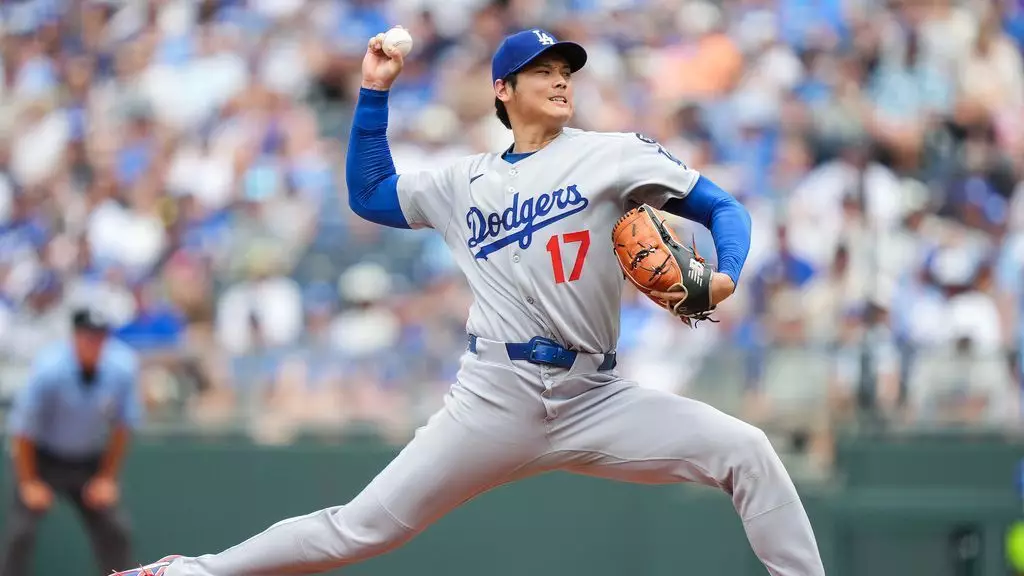Shohei Ohtani’s recent outing with the Los Angeles Dodgers serves as an emphatic reminder of his extraordinary talent and resilience as a two-way player. After recovering from Tommy John surgery and missing all of last season, Ohtani demonstrated not only his physical recovery but also his competitive fire by delivering a career-high fastball velocity of 101.7 mph in an actual game setting. This performance is noteworthy—not merely because speed is a raw measurable— but because it signals the successful progression of his painstaking reintegration into pitching without compromising his effectiveness.
In his third pitching start—and first multi-inning appearance this season—Ohtani’s ability to execute under pressure was evident. Pitching two innings, giving up just one hit and a walk, he showed remarkable command by striking out three batters and consistently throwing first-pitch strikes. For a player who is easing back into the mound role, these metrics reveal a command and control that surpass expectations. This kind of efficiency, along with his willingness to challenge hitters with triple-digit heat, indicates a strategic maturity seldom seen in players with fewer pitching appearances over a comparable timeframe.
The Physical and Mental Dimensions of Ohtani’s Return
Ohtani’s story this season cannot be told without acknowledging the mental toughness required to return from a major elbow surgery, particularly for a player balancing dual roles on the battlefield of MLB. The mental fortitude to throw fastballs north of 100 mph — a feat usually achievable only when fully confident and healthy — points to both rigorous physical rehabilitation and immense psychological preparation. As Dodgers’ manager Dave Roberts noted, seeing Ohtani freely crossing the triple-digit threshold is reassuring not just for the team, but for Ohtani himself as he assesses his body’s response post-surgery.
Moreover, Ohtani’s pitching approach reflects a nuanced understanding of the game’s mental chess. Invoking sliders to complement his fastball and inducing a double play with timely pitching decisions signify a pitcher gradually regaining his strategic edge. The deliberate pacing and measured aggression recalled from his pre-surgery days affirm that Ohtani is not rushing the comeback but thoughtfully charting his course back to dominance.
Reimagining the Two-Way Player Role in Modern Baseball
Ohtani’s presence in the MLB as a prolific hitter and increasingly competent pitcher challenges baseball’s traditional compartmentalization between pitching and hitting roles. His ability to produce 29 home runs this season while simultaneously stepping back onto the mound exemplifies a unique duality rare in today’s sport. Yet, his selective reservations about participating in the upcoming Home Run Derby highlight the practical limits of his dual commitments. Ohtani’s acknowledgment of the current rules limiting his ability to compete effectively in such events underscores the broader challenges two-way players face in balancing workload, recovery, and peak performance.
This candid stance does not detract from his remarkable season; rather, it showcases a mature athlete who prioritizes sustainability over spectacle. His choice reveals an understanding that managing his physique to excel in two demanding roles requires calculated decisions that might challenge fan expectations but ultimately serve long-term success.
The Competitive Spirit Beyond Numbers
Ohtani’s interactions with opposing players also shed light on the respect his talent commands. When Kansas City’s Vinnie Pasquantino recounted facing Ohtani’s fastest pitches—both on American soil and during the World Baseball Classic—it highlighted how Ohtani’s velocity and command are not just statistics but psychological weapons. The fact that Pasquantino hopes to confront Ohtani and “talk” about those blazing fastballs underscores the intimidation factor Ohtani wields, which amplifies his impact beyond traditional analytics.
For a player returning from a significant injury and evolving his pitching repertoire, the intangible quality of fierce competitiveness remains a cornerstone. As Dodgers’ management observes, Ohtani’s unwillingness to dial down his intensity—even in early comeback stages—reveals a competitor who thrives on pushing boundaries, refusing to settle for anything less than excellence.
Charting a Future Beyond Conventional Expectations
Shohei Ohtani stands as a transformative figure in baseball’s contemporary landscape, not just by virtue of his raw talent but through navigating unprecedented physical and mental challenges. His dedication to refining his craft on the mound while maintaining offensive production defies conventional narratives about specialization in professional sports. Although his comeback is ongoing, Ohtani’s current performances are already rewriting what is possible for two-way players.
His mindful approach—coupled with flashes of brilliance like that 101.7 mph fastball—signals a trajectory towards sustained greatness that blends athletic prowess with strategic pacing. Ohtani’s journey is a testament to perseverance and innovation, inspiring observers to reconsider the limits athletes can surpass when passion, resilience, and skill intersect seamlessly on the bright stage of Major League Baseball.


Leave a Reply